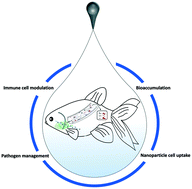Polymer-coated TiO2 nanoparticles bioaccumulate, immunoactivate and suppress pathogenic Mycobacterium chelonae clearance when intravenously injected into goldfish (Carassius auratus L.)†
Abstract
Immunological responses to nanoparticle (NP) exposures have been extensively reported using in vitro cell models. Results show that metal-based NPs and NPs functionalized by a polyacrylic acid (PAA) polymer elicit both the activation of pro-inflammatory markers and the suppression of others. However, the translation of these immunotoxic effects to ecological in vivo models has not been explored to the same extent, despite evidence showing that the vast majority of NPs that enter vascular circulation in fish are deposited into the kidneys and spleen, which are their major hematopoietic organs and where many immune cells reside. The long-term presence of NPs in these immune organs increases the opportunity to affect immune responses to both NPs and pathogens. In this study, we examined goldfish immunotoxicological responses to intravenously injected PAA-TiO2 NPs (1 μg g−1) by determining organ accumulation, depuration, tissue damage, and immune responsiveness in the kidneys, spleen, and isolated primary kidney neutrophils. Results showed significant deposition of Ti metal in the kidney, and especially spleen tissues that remained elevated for the 28 day study. Confocal imaging demonstrated that kidney neutrophils also internalized injected PAA-NPs in vivo, and there was increased lipid peroxidation in kidney and spleen tissues. Degranulatory and respiratory burst immune effector functions of isolated neutrophils were also potentiated at each time point, and there were significant changes in pro- and anti-inflammatory-related genes in hematopoietic organs of PAA-TiO2-injected fish. Finally, NP-injected fish also had significantly decreased capacity to clear a pathogenic (Mycobacterium chelonae) infection from the spleen following a 28 day pathogen challenge, suggesting a potential risk to long-term health and viability of NP-exposed fish.



 Please wait while we load your content...
Please wait while we load your content...